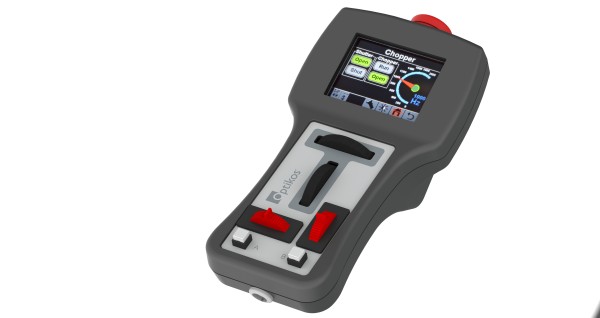Fifteen Years of Experience
The HC-1000 is a handheld controller for the Optikos Motion Control (OMC) system that retains the indispensable features of its predecessor while adding capabilities that sophisticated users have come to expect in the age of smart handheld devices. More than fifteen years ago, Optikos introduced the MCS-10, a handheld controller that incorporated both proportional speed and fine positioning controls in a single unit. Users of infrared test benches in particular have found these features invaluable when searching for the focus of an infrared lens. We solicited suggestions for improvements from these same users and have incorporated their feedback into the design of the HC-1000. For example, the two-axis joystick used in the MCS-10 could sometimes result in unintended motion in the second axis when inadvertently pushed forward diagonally. The HC-1000 controller circumvents this problem by featuring two separate single-axis joysticks. And we selected non-contact Hall effect joysticks to make sure they lasted a long time.
Applicability
The HC-1000 works exclusively with the OMC system, Optikos’ next generation of decentralized motion control. This system distributes intelligent controls within subsystems and then links these elements with three buses: 36VDC power, CANbus, and E-Stop. The HC-1000 interfaces to these three buses through a single cable that connects to a PS-1300 series power supply. The controller automatically detects all OMC systems that are present on the CANbus, downloads the relevant data from these devices, and presents the corresponding control interfaces to the user. Both motion control elements and the OG-1000 series of object generators may be remotely controlled from the HC-1000.
User Interface
Intended primarily for handheld use, the HC-1000 is housed in an ergonomic enclosure that is more readily held in a single hand that was the case with its predecessor, the MCS-10. It is, however, still comfortable to place the HC-1000 on a flat surface and operate it with a single hand.
The user interface consists of several tactile controls located in the lower portion of the controller below a color touchscreen interface. The tactile controls for motion are divided into two sets arranged vertically and horizontally. The touchscreen interface allows the user to assign each set of controls to a particular motion axis. Each set comprises a single axis joystick for slewing the corresponding axis in proportional velocity mode, and a thumbwheel for fine positioning. At the very bottom of the front panel are located two illuminated teach buttons which may be taught the positions of all motorized axes by holding them in for two seconds. They may then be used to return all axes to the taught position by a single press. Any user who has “found” the image of an infrared lens and then inadvertently walked away from it while attempting to refine the focus will appreciate the ability to mark and return to this first position!
The touch screen is designed around a hierarchy of screens with each one incorporating a control to move back up a level or to return to the home screen. Control of the OG-1000 is effected entirely through the touchscreen where the user will find replicated all of the controls on the OG-1000 control panel. The touchscreen is also used to assign motion axes to the tactile controls, to invert the sense of these controls, to set the sensitivity of the tactile controls, and to display the current positions of all of the axes.
When working in the dark with sensitive equipment it is sometimes necessary to extinguish all sources of visible light. A control on every screen enables the user to darken the display as well as to extinguish the light of illuminated buttons. A simply tap to the touchscreen restores the display. Another frustration of working in the dark is trying to find a flashlight. The HC-1000 incorporates a pair of white LEDs to provide temporary illumination in these conditions.
E-Stop
The emergency stop bus is an independent bus in the OMC that connects directly to the low-level motor amplifiers found in the distributed controllers. A red mushroom E-stop button connected to this bus is mounted immediately above the touchscreen display. The operator has only to hit this button to cause an immediate stop to occur on all motion axes. Twisting the button to release it will cause the system to recover elegantly from this condition.


